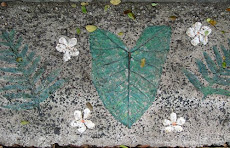| 
Last spring, the Bureau of Indian Affairs (BIA) Office of Indian Education Programs (OIEP) moved from Washington, D.C. to Albuquerque, New Mexico. The new southwest location enticed two very special people to it. Barbara Parisian (Blackfeet) and Darrell Flyingman (Choctaw), are both dedicated to educating American Indian youth, and were ready to take on their new challenge; filling vacancies in the BIA school system. But how?
Barbara is an Education Specialist having spent 26 years in the school system. She worked for the Department of Education in D.C. in the early 90's, and from through 1998 as was a school principal in rural Montana. She always wanted to live in the southwest so when she heard about the job she currently holds, she applied for it. Now in the BIA OIEP Division of School Improvement, Barbara explained, "We [OIEP] have a comprehensive system of personnel developing that requires us to go out recruit, train and retain quality teachers in the areas of special education as well as general education. We also offer summer institutes where teachers can get credits."
Darrell is a Personnel Management Specialist in the Human Resources Office. He came from Lawrence, Kansas; Haskell Indian Nations University. "It was hard to leave Haskell, but my wife and I decided it was time to do something different," he said.
Darrell told me how the 1st Annual Indian Education Teacher Recruitment Week came about. He and Barbara had a meeting one day to discuss bringing "more teachers into Indian country. At that time, I think we were 150 -200 teachers short. So, we started kicking around different ideas." They came up with the idea to have a teacher's recruitment week. They chose the week of April 16th because Santa Fe Indian School was on spring break, and that way the teachers they planned to recruit could live in the dorms, "to see how the students live," said Darrell.
They then presented their plan to Kevin Skenandore (Oglala,Oneida), Division Chief of the Division of School Improvement who thought it was a great idea. Kevin then proceeded to find the funds to make their plan a reality.
Barbara and Darrell sent the announcement out to Native Americans in the educational field. Altogether 43 people received the all expense paid trip for the 1st Annual Teachers Recruitment Week in Santa Fe, to learn about the many opportunities the BIA school system has to offer and to experience some BIA schools.
Monday, the teachers came from around the country. On Tuesday, they all gathered in a beautiful new auditorium at the SFIS. First they were welcomed by Joseph Abeyta (Santa Clara Pueblo), Superintendent at the SFIS, Ray Gachupin (Jemez Pueblo), Director of Student Programs at SFIS, and Walter Dasheno (Santa Clara Pueblo), Governor and liaison between the Pueblo Governors and the school.
Then Barbara introduced the panel of speakers starting with Dr. Angelita Felix (Arikara), who is with the BIA Division of School Improvement. Dr. Felix said, "We don't want a person that just wants a job, we want you to come because you think you can make a difference in a childs life." She talked of how wonderful it has been for her to learn about different tribes from teaching in several BIA schools. She also shared her experiences regarding the challenges first time teachers face as well as giving the soon-to-be teachers some tips.
With high praise, Dr. Felix introduced Isaac Casados, a dynamic 19-year old young man who was involved in many school programs while attending SFIS and is now a freshman at Georgetown University. Isaac grew up off-reservation; born in Portales, NM, his mom is Navajo and his dad, Hispanic and Anglo from Santa Fe. Growing up he spent time on both the Navajo Reservation and at Santa Clara Pueblo where his mom taught school, and still does. Isaac stressed the importance of the work the teachers would soon begin, "when a child walks into a classroom, the anticipation that they have is the same anticipation that first year teachers have, however do you understand the difference you are going to make in that childs life?"
Isaac works in Washington D.C. for Congressman Udall and Senators Biden, and Kennedy reviewing bills, while majoring in international politics, "law school probably after that." He is also the CEO of ASM Media Group, which will be launched in January of 2002 with their first publication of "The Rag." I expressed my amazement at all he does, and he responded, "Anybody can do anything as long as they have the will and the initiative."
Then Don Sims (Choctaw), Superintendent of Riverside Indian School in Oklahoma talked of the joy he has received teaching the kids, and the wonderful teachers that made a difference in his life, and how he now enjoys giving it back to the kids he teaches. "You are going to be the major reason why kids succeed or don't. Beside reading writing and arithmetic, "I suggest to you, you need to teach self-reliance, you should teach persistence, self-motivation, service to others, teach courage, dignity and love. If you do that in your classroom everyday, then the students that are experiencing your giving; that experience will echo in them the next day, and the next."
Several speakers brought up the importance of having Indian teachers as role models teaching Indian students.
Ed Parisian (Cree), Education Superintendent of the Eight Northern Pueblo Agency, said he wanted to be a teacher and coach since elementary school because of the teachers he had that made a difference in his life. He also talked of the educational goals the Bureau has set for the next five years based on culturally appropriate instructional materials and indigenous values.
(see sidebar) 
SIDEBAR -
[The Division of School Improvement is just that. According to a document handed out to everyone, "Members of the Indian Community School, Inc.'s Board of Directors for 1999-2000 created a document called Guidelines for the Selection of Culturally Appropriate Instructional Materials. This document was "developed to assist teachers and others in the schools how to analyze instructional materials for American Indian students with respect to critical elements in the areas of subject matter, content, organization structure, student experience, teaching strategies, assessment and equity."
According to the manual, teaching must be based on these basic requirements: "1) Materials should reflect high expectations of all students; 2) use local cultural and environmental knowledge; 3) provide numerous and appropriate experiences that encourage students to develop confidence in their own critical thinking; 4) ensure active participation of students in learning, doing, and evaluating content; 5) reflect current research; 6) reflect a developmentally appropriate sequence and allow for teacher flexibility; and finally, 6) challenge students to construct choices and make decisions, subject each action and outcome to reflection using indigenous values."]
The teachers were surprised to learn that there are 185 BIA schools located on 63 Native Nations in 23 states. The BIA school system has about 4,900 teachers, administrators, counselors, and support personnel.
Tuesday afternoon and Thursday were spent touring various schools on the Pueblos in the area. This enabled the teachers to meet and network with educators, principals, children and others involved in Indian education.
On Wednesday the teachers heard from Kevin Skenandore, Division Chief of DSI and were given the BIA orientation/benefit packages and learned about residential living and computer connections.
The teachers were also given the opportunity to meet principals from other BIA schools at a job fair that was organized for them at SFIS. The Principals came with the hope of recruiting much-needed teachers in their areas.
Darrell told me that the principals, paid their own way, coming from "Washington, Oregon, Oklahoma, South Dakota, North Dakota, Montana, Arizona, California, New Mexico, just about every state where we have a lot of Native Americans."
During the week, the teachers were also taken to San Juan Pueblo's new casino, and enjoyed a traditional Pueblo meal at Santa Clara Tribal Facility where they were entertained by Pueblo and Navajo youth.
On their last evening there was Banquet with award presentations at the Courtyard Marriott in Santa Fe, which is where I caught up with them again, curious to hear how the week went for everyone. The banquet hall filled with enthusiastic teachers, who after a week together, had all become good friends.
Darrell Flyingman took me around to talk with several of the participants to hear how they felt about the week.
First, Donald Pine, (Lakota, Standing Rock Sioux) shared his thoughts. Donald has been working his way through school at Fort Hall, a tribal school in Idaho. He worked days to support his family including four children, and went to school nights. About the week, Donald smiled and said, "It was really a wonderful opportunity to see so many other Indians who are going to be professionals, and to network. I've actually made some really good friends this week, it's been a really positive experience." He was surprised to learn, as were many others, about all the opportunities there are for teaching within the BIA educational system. He is thinking of teaching in New Mexico or South Dakota.
Then a bubbly Karen Galloway (Choctaw from Oklahoma) talked with us. Karen, who after raising her children, went back to school to get her Masters in Special Education. She had a great experience during the week as well. "My head is spinning, there are so many things to think about and decisions to make. I made some good contacts." She has decided on New Mexico. She was impressed with the school at Isleta Pueblo, and "will see what happens." Her grown children are happy about her move; researched NM on the Net, and think it's great, and may move from Oklahoma to join her here.
Then Darrell took me to a table where four members of a family from Montana were sitting. Craig Wellman (Blackfeet) came with his wife, nephew, and his sister. With great enthusiasm, Craig shared his thoughts, "Had a great week, I am really excited about it. As far as a first time [recruitment program] it was great. The entire concept; it needs to be done, it should have happened sooner, but at least it's happening now." His sister has been teaching for seven years, he and his wife will student teach this fall. Where would they like to teach? "We've already had several offers, we want to teach in New Mexico." Craig and his wife have five children, three in college, and an 8th and a 9th grader.
Darrell felt they selected a very good group of new teachers out of the many that applied. Everyone there felt the 1stAnnual Indian Education Teacher Recruitment Week was a great success.
After dinner, Darrell and Barbara gave everyone a certificate for attending the session. Darrell told them he would be sending out emails and faxes for feedback on the week, and hoped they would keep in touch and let Barbara or himself know when and where they got a job within the BIA Educational Program.
Talking about their future teaching jobs, Barbara stressed the importance of asking questions, learning about the community they work in, becoming part of the community, and acting professionally at all times. She also talked of the importance of continuing to set goals for themselves.
The teachers commended and thanked Barbara, Darrell and the others who they spent the week with. Many remarked about the wonderful opportunities and eye opening experiences they were given especially by going into so many schools.
Darrell feels there are many teachers out there that would probably like to work in Indian country, but "they just don't know about it. So, we have developed a web page so they can pull up the different job vacancies throughout Indian country. Like administration, or maybe somebody is looking for a bus driving job, or to be a cook. So we are trying to get the word out." If you or someone you know may be interested in working with and motivating Indian youth, <http://www.biaeducationjobs.com > or
< http://www.oiep.bia.edu >
are the web sites to visit. Suzanne Westerly
Photojournalist
POB 31340
Santa Fe, NM 87594
P/F 505-989-1968 cell 505 -670-1644
suzannewesterly@earthlink.net |


































